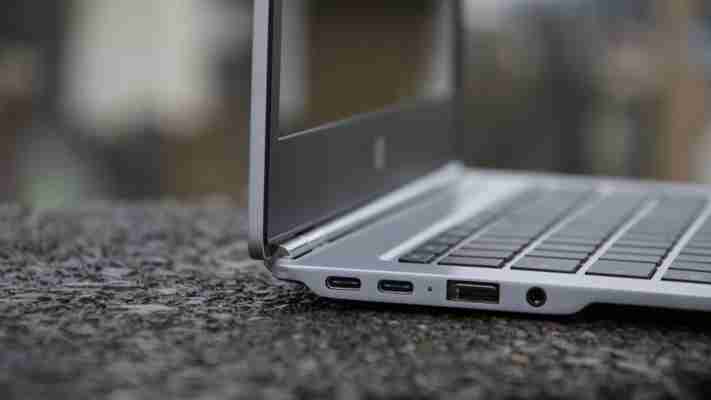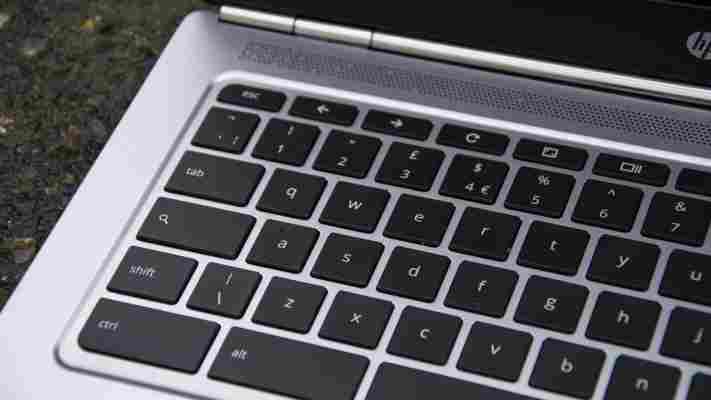You might start reading this with a deep-rooted cynicism toward Chromebooks. Opinions have been sullied over the years due to plastic-ridden, Celeron-powered devices with sub-par screens. HP’s latest Chromebook 13 is here to rewrite your perceptions, and it does so – on the whole – magnificently.
Inside and out, HP makes few sacrifices. Its looks are bewitching, with its dark grey, brushed-aluminium chassis accompanied by a backlit keyboard. This sophisticated Chromebook leaves my previous favourite, Acer’s Chromebook 14 , buried in the dirt.
Standing a mere 12mm tall on the desk, it’s also one of the slimmest Chromebooks around. Combined with its dainty 1.2kg weight, HP’s Chromebook 13 is stylish and feels reassuringly expensive – which is just as well, given the rather steep asking price.

While the Acer Chromebook 14 will set you back a mere £200, you’ll have to fork out at least £600 for this Intel Core-m3, Quad HD-equipped model . This isn’t a typical budget Chromebook, however, and should instead be considered a proper alternative to a Windows laptop.
HP Chromebook 13 review: Display and keyboard
The first piece of evidence: the screen. Aside from Toshiba’s ancient IPS-equipped Chromebook 2 , displays are seldom a selling point for Chromebooks. But HP ships this Chromebook with a Quad HD IPS panel. This 13.3in, 3,200 x 1,800 display beams out at 358cd/m2, perfect for sunny afternoons, while an sRGB coverage of 88% promises a good spread of colours. However, the display is marred by a seriously poor 474:1 contrast ratio, giving images a flat, washed-out look. It’s by no means awful, but for this price I expected better.
Still, to the untrained eye, the screen on the Chromebook 13 isn’t bad. It’s just that it isn’t great. And at this price, I’d also liked to have seen a touchscreen. If nothing else, this would make those ported Android apps on the Chrome Web Store much easier to use.
And, while it’s hardly HP’s fault, it’s also worth pointing out that Chrome OS still struggles with resolution scaling. At any resolution higher than Full HD, it displays a laughably microscopic mouse cursor and such small app icons you have to squint to see. I had to nudge it down a peg or two to make it usable.

When it comes to the keyboard, the individually backlit keys are nicely spaced inside the 13in chassis and although the low travel takes a bit of getting used to, the stiff switches make for crisp, responsive typing. The diamond-edged touchpad is generously sized, too, and responsive both to standard mousing and multitouch gestures. I'm not a huge fan of integrated buttons in general, but the HP's are relatively easy to get used to and are, by-and-large, inoffensive.
HP Chromebook 13 review: Performance and battery life
The display might be disappointing, but it’s good to see that the Chromebook 13 is crammed with nippy core components. For the £600 asking price, you get a dual-core, 0.9GHz Intel Core m3-6Y30 processor, 4GB of RAM and 32GB of eMMC flash storage – a Chrome OS-powered laptop that’s well ahead of the pack.


It scored 128 in the JetStream browser benchmark – the highest we’ve seen – twice that of HP’s elderly Chromebook 14 and its 52.9 result. It felt wonderfully nippy in general use, flitting between multiple Chrome tabs without breaking a sweat. If you’re in need of a Chromebook that isn’t already obsolete straight out of the box, it’s a very good start.
That Core m3 is a tad more power-hungry than its Celeron alternatives, though, draining the Chromebook 13’s 5,000mAh battery in 7hrs 20mins in our video-playback test . That said, you should be able to eke out a full working day from a single charge, as long as you don’t run the screen at maximum brightness.
HP Chromebook 13 review: Ports and connections
As with most Chromebooks, the port selection is a tad restrictive with only two USB 3.1 Type-C ports (with one used for charging) and a single regular USB 3.1 socket for legacy device connection.
The good news is that you can use that spare Type-C socket to connect the HP Chromebook to a variety of high-speed peripherals, including external monitors. There’s also a solitary microSD card reader for expandable storage embedded on the right-hand side.
As for networking, you’ll have to either stick with the onboard 802.11ac Wi-Fi adapter (there’s no built-in Ethernet socket) or buy an adapter for use over USB. Finally, there’s Bluetooth 4.2 for hooking up additional peripherals such as headphones, mice and keyboards.
HP Chromebook 13 review: Verdict
HP’s Chromebook 13 might seem a little overpriced but, in reality, it’s a marvel. It’s a standout Chrome OS laptop with great performance and a crisp Quad HD display, and the ultra-light chassis and all-day battery life make it a portable workhorse that's a joy to use.
If you’re after something that can effortlessly butt heads with pricier Windows-powered laptops, there’s nothing like it. Despite its display shortcomings, this is the Chromebook to beat.
| Core specs | |
|---|---|
| Processor | Dual-core 0.9GHz Intel Core m3-6Y30 |
| RAM | 4GB |
| Memory slots (free) | 1 (0) |
| Max memory | 16GB |
| Dimensions | 319x219x12.7mm |
| Weight | 1.2Kg |
| Sound | Realtek HD Audio (3.5mm headset port) |
| Pointing device | Touchpad |
| Display | |
| Screen size | 13.3 |
| Screen resolution | 2,560 x 1,440 |
| Touchscreen | No |
| Graphics adaptor | Intel HD Graphics 515 |
| Graphics outputs | USB-C |
| Graphics memory | 1GB |
| Storage | |
| Total storage | 32GB |
| Optical drive type | N/A |
| Ports and expansion | |
| USB ports | 2x USB-C, 1xUSB 3.1 |
| Bluetooth | 4.2 |
| Networking | 802.11ac wireless |
| Memory card reader | SD |
| Other ports | N/A |











